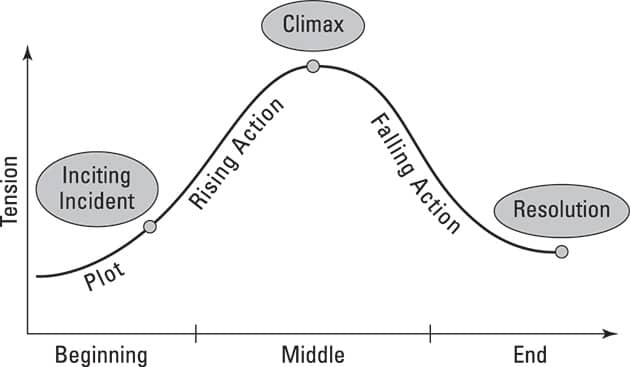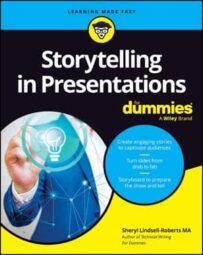You can use this innate storytelling ability to create presentations that engage your audience, rather than put them to sleep.
Don't have time to read the entire article? Jump to the quick read summary.
 ©Jacob Lund / Adobe Stock
©Jacob Lund / Adobe StockWhat do we think of when we hear "presentation?" PowerPoint slides. And, yes, slides are helpful — but they're helpful as visual aids, not as the main storyteller.
Good storytelling can make your presentations sizzle in ways that slides can’t.
An introduction to storyopia
When people ask or search for "how to create a presentation," or "how to create a PowerPoint presentation," they're focusing on the technical aspect of the process. Of course, that's important. However, there's something even more critical to consider before you get down to creating your slides: Storyopia.My concept of Storyopia represents the ideal. It's marriage of the words "story" and "utopia." It’s the ideal story that takes the audience on a journey from what is to what could be; a journey to where they see themselves as heroes along that same path.
Try to recall presentations you’ve attended. What drove the presentation? Bullet points? Charts? Tables? The monotonous drone of a facilitator plodding through a dry rendition of data? My guess is all of them. (A pretty tedious experience.)
Since people began to communicate, storytelling has been the lifeblood to getting points or ideas across and making them memorable. Stories make ideas and words come alive. They explain examples or points of view in a way that resonates. People naturally connect emotionally with stories, associating their feelings with their learning.
Stories aren’t meant to be objective. They’re meant to sway emotions, generate suspense, add surprise, create wonder, facilitate the call to action, and take your audience on a journey to success.
Using the story arc
When you create a presentation, keep the story arc in mind. The figure below shows the typical story arc (also known as dramatic arc or narrative arc). It represents storyopia. When creating a story using the arc as a guide, your story will have a natural, connected flow:- Cite the incident (the plot) telling what is.
- Build rising tension toward the climax.
- Work towards the resolution, which is what could be.
 ©John Wiley & Sons, Inc.
©John Wiley & Sons, Inc.The story arc
Always create tension in your story. It’s critical but often overlooked. If the tension isn’t obvious, this is a good opportunity to embellish with a story. After you’ve filled out a start-up brief — a tool for identifying your audience — you’ll have a good idea of your audience’s pain and what matters to them. Focus on storyopia: the gap between what is and what can be. Take them on that journey so they see themselves as heroes on the same path.
To learn more about the start-up brief, as well as storyboarding and other helpful tools for preparing excellent presentations, grab a copy of my book/eBook Storytelling in Presentations For Dummies.
As part of creating presentations, your story will have characters: people, companies, or things, such as processes or equipment. There will be goals, struggles, challenges, and a positive or negative outcome. Either outcome serves as a valuable lesson. Let’s see how beginnings, middles, and ends can become a story:- Beginning: Introduce characters with the same challenge, problem, complication, or issue your audience is facing — the reason they’re attending. You’ll hook them because they’ll feel like they’re in the same situation. Edit the details to keep the story simple and relatable. You may start with, “One of my customers was dealing with your exact issue(s).”
- Middle: You’ve already sparked their curiosity. Now focus on the characters’ problems and how your solution brought the change they needed. Don’t merely go from Point A to Point B. The long cuts and shortcuts are what make the journey interesting, worthwhile, and relatable.
- End: This is where you tie it together, targeted to the CTA. Deliver the main takeaways and lessons your audience should remember based on the success of your characters. Let your audience see the happy ending where they imagine themselves as heroes achieving these same positive outcomes.
Always give your characters names to make them more relatable, but change the names for the purpose of anonymity. People don’t identify with words such as attendee, coworker, colleague, or manager. Also, provide a vivid description of your main character and the setting so your audience can envision the scenario and place themselves in the situation.
For example, if you’re presenting to a group about sales strategies because sales have been slumping, you may share a story of [name] who worked for [company for x years] and how he was able to bring his sales and commissions up to a much higher level by [strategy].Pitting the heroes against the villains
From bedtime stories when we were kids to great novels and movies as we became older, a good story draws us. We love heroes. They display qualities we admire. They show us how to overcome challenges. We can recall superhero caped crusaders: Batman, Batgirl, Superman, Zorro, Shazam, Wonder Woman, Scarlet Witch, Thor, and others. We all want to be superheroes and live happily ever after in our worlds of family, friends, and business.Are there heroes in business presentations? Absolutely — the audience! This is how heroes and villains play a role in happy endings:
-
Heroes: Think of the character Yoda from the Star Wars series. Yoda was the legendary Jedi Master who trained Jedi Knights for 800 years. Yoda was cool. He was a hero in addition to being a mentor and instructor. He unlocked the path to immortality in characters such as Han Solo, Luke Skywalker, Obi-Wan Kenobi, and others who became heroes in their own rights. You can be the Yoda in your presentation, unlocking the path to slaying the villain and guiding your audience toward success.
Heroes can even be antiheroes — people who display true human nature. People who make poor decisions that may harm those around them, intentionally or not. Some are even well intentioned, such as Robin Hood, the classical literary antihero. He stole from the rich (bad) and gave to the poor (good). Even Donald Duck has been labeled antihero for his short and often explosive temper.
-
Villains: Without villains (often the most interesting characters) there would be no stories and no heroes. For example, if not for Cruella De Vil, 101 Dalmatians would merely feature lots of spotted canines running around. Without Scar in The Lion King scheming to be next in line to seize the throne, there would be no story, and Simba wouldn’t have become a hero.
In business, the villain is the problem or challenge. That can be unscrupulous people, anti-technology diehards, a combative person, the competition, and so on. A villain may also be a non-person: a specific event, befuddled communication, meager lead generation, declining customer base, poor cash flow, inability to retain valuable employees, failure to balance quality and growth, software that isn’t producing as expected, and so much more.
- Happy endings: You don’t want the victory to be too easy or too predictable — it kills the interest and suspense. At the beginning of every story the villain must be strong, the victim’s problems must seem insurmountable, and the hero’s task must seem challenging. Your story needs an imagined future where the audience puts themselves in the place of slaying their villain and making themselves heroes.
- Add $$$ to their bottom line
- Become more innovative
- Discover the right tools or technology
- Take a leadership position
- Communicate with impact
- Get the big contract signed
- Procure a grant
Quick Read Summary
In our daily lives, we often use hyperboles to add zest to our stories, making them more engaging. But when it comes to presentations, we tend to default to bullet points and charts, which can be monotonous. However, there's a better way to captivate your audience: the art of storytelling.
Think of a presentation, and you might envision PowerPoint slides. While slides have their place as visual aids, the real storyteller should be you. Good storytelling can infuse life into your presentations, leaving a lasting impact on your audience.
Before diving into creating slides, consider "Storyopia," a concept that merges "story" and "utopia." Storyopia is the ideal narrative that takes your audience on a journey from the current reality to what could be, casting them as heroes along the way.
Storytelling is a timeless means of communication. It breathes life into ideas and words, resonating emotionally with your audience. Stories are not meant to be objective but to evoke emotions, generate suspense, and facilitate the call to action.
When crafting a presentation, keep the story arc in mind:
- Cite the Incident (What Is): Start by presenting the current scenario, laying out the facts.
- Build Tension: Create rising tension, keeping your audience engaged and curious.
- Work Towards Resolution (What Could Be): Guide your audience toward a better future, making them see themselves as heroes on the journey.
To make your story relatable, introduce characters facing the same challenges as your audience. In the middle, highlight their struggles and how your solution brought positive change. End with the takeaways and lessons your audience should remember.
Heroes and villains play a crucial role in your narrative. Your audience becomes the hero, looking to you as their guide (like Yoda in Star Wars), helping them overcome the villain (the problem or challenge). The villain can take various forms, from uncooperative individuals to technological obstacles.
To ensure an engaging story, make the victory challenging but achievable. Your audience should envision themselves slaying their own villains and becoming heroes in their respective narratives.
Incorporate storytelling into your presentations to inspire your audience and leave a lasting impact. Whether it's increasing profits, fostering innovation, or solving challenges, your storytelling can guide them to success.
Unleash the power of Storyopia and transform your presentations from mundane to unforgettable. Make your audience the hero in their own story of triumph.
Hungry for more? Go back and read the article or check out the book.

